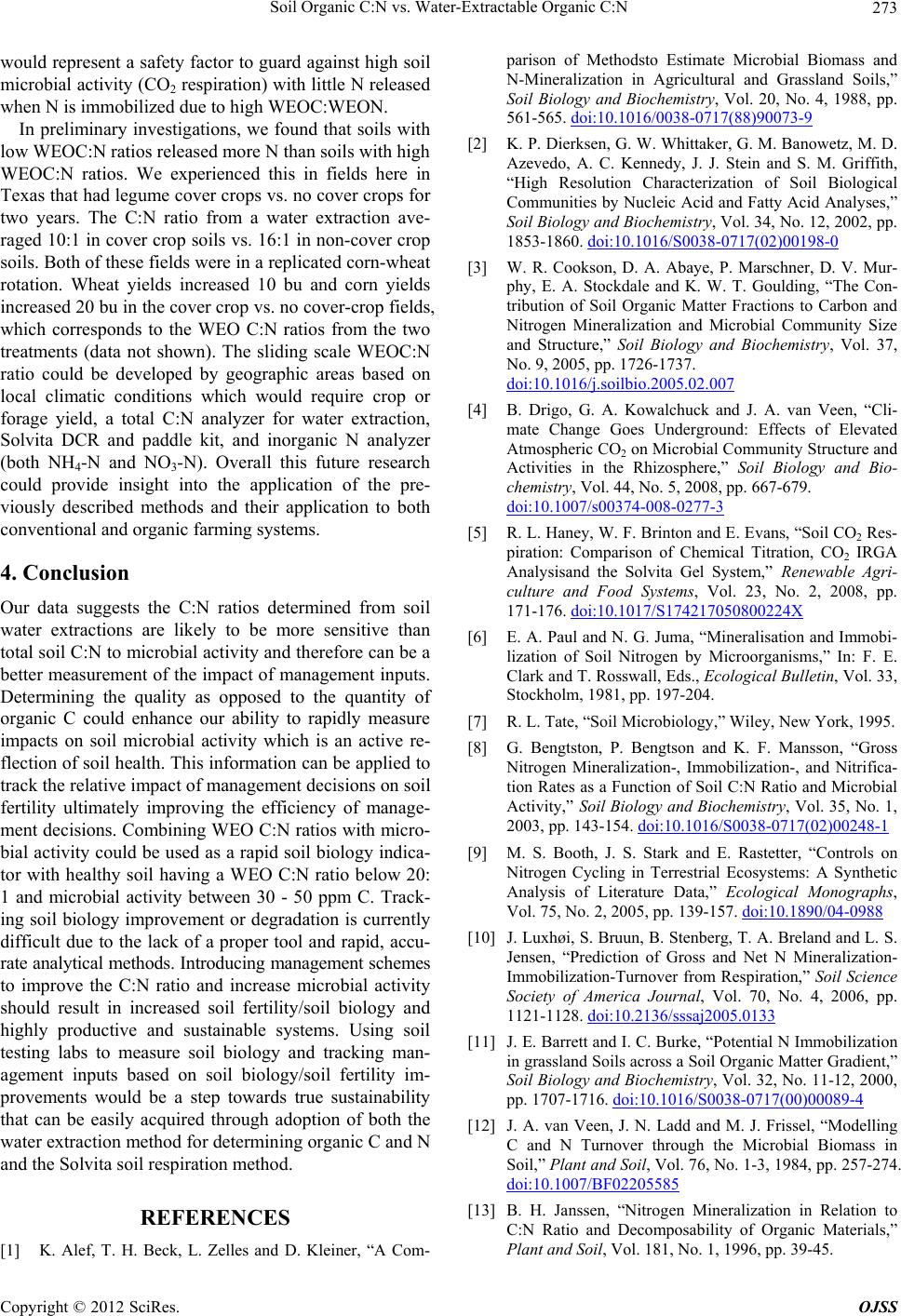
Soil Organic C:N vs. Water-Extractable Organic C:N 273
would represent a safety factor to guard against high soil
microbial activity (CO2 respiration) with little N released
when N is immobilized due to high WEOC:WEON.
In preliminary investigations, we found that soils with
low WEOC:N ratios released more N than soils with high
WEOC:N ratios. We experienced this in fields here in
Texas that had legume cover crops vs. no cover crops for
two years. The C:N ratio from a water extraction ave-
raged 10:1 in cov er crop soils vs. 16:1 in non- cover crop
soils. Both of these fields were in a replicated corn-wheat
rotation. Wheat yields increased 10 bu and corn yields
increased 20 bu in the cover crop vs. no cover-crop f ield s,
which corresponds to the WEO C:N ratios from the two
treatments (data not shown). The sliding scale WEOC:N
ratio could be developed by geographic areas based on
local climatic conditions which would require crop or
forage yield, a total C:N analyzer for water extraction,
Solvita DCR and paddle kit, and inorganic N analyzer
(both NH4-N and NO3-N). Overall this future research
could provide insight into the application of the pre-
viously described methods and their application to both
conventional and organic farming systems.
4. Conclusion
Our data suggests the C:N ratios determined from soil
water extractions are likely to be more sensitive than
total soil C:N to microbial activity an d therefore can be a
better measurement of the impact of management inputs.
Determining the quality as opposed to the quantity of
organic C could enhance our ability to rapidly measure
impacts on soil microbial activity which is an active re-
flection of soil health. This informatio n can be applied to
track the relative impact of management decisions on soil
fertility ultimately improving the efficiency of manage-
ment decisions. Combining WEO C:N ratios with micro-
bial activity could be used as a rapid soil biology indica-
tor with healthy soil having a WEO C:N ratio below 20:
1 and microbial activity between 30 - 50 ppm C. Track-
ing soil biology improvement or degradation is currently
difficult due to the lack of a proper tool and rapid, accu-
rate analytical methods. Introducing management schemes
to improve the C:N ratio and increase microbial activity
should result in increased soil fertility/soil biology and
highly productive and sustainable systems. Using soil
testing labs to measure soil biology and tracking man-
agement inputs based on soil biology/soil fertility im-
provements would be a step towards true sustainability
that can be easily acquired through adoption of both the
water extraction method for determining organic C and N
and the Solvita soil respiration method.
REFERENCES
[1] K. Alef, T. H. Beck, L. Zelles and D. Kleiner, “A Com-
parison of Methodsto Estimate Microbial Biomass and
N-Mineralization in Agricultural and Grassland Soils,”
Soil Biology and Biochemistry, Vol. 20, No. 4, 1988, pp.
561-565. doi:10.1016/0038-0717(88)90073-9
[2] K. P. Dierksen, G. W. Whittaker, G. M. Banowetz, M. D.
Azevedo, A. C. Kennedy, J. J. Stein and S. M. Griffith,
“High Resolution Characterization of Soil Biological
Communities by Nucleic Acid and Fatty Acid Analyses,”
Soil Biology and Biochemistry, Vol. 34, No. 12, 2002, pp.
1853-1860. doi:10.1016/S0038-0717(02)00198-0
[3] W. R. Cookson, D. A. Abaye, P. Marschner, D. V. Mur-
phy, E. A. Stockdale and K. W. T. Goulding, “The Con-
tribution of Soil Organic Matter Fractions to Carbon and
Nitrogen Mineralization and Microbial Community Size
and Structure,” Soil Biology and Biochemistry, Vol. 37,
No. 9, 2005, pp. 1726-1737.
doi:10.1016/j.soilbio.2005.02.007
[4] B. Drigo, G. A. Kowalchuck and J. A. van Veen, “Cli-
mate Change Goes Underground: Effects of Elevated
Atmospheric CO2 on Microbial Community Structure and
Activities in the Rhizosphere,” Soil Biology and Bio-
chemistry, Vol. 44, No. 5, 2008, pp. 667-679.
doi:10.1007/s00374-008-0277-3
[5] R. L. Haney, W. F. Brinton and E. Evans, “Soil CO2 Res-
piration: Comparison of Chemical Titration, CO2 IRGA
Analysisand the Solvita Gel System,” Renewable Agri-
culture and Food Systems, Vol. 23, No. 2, 2008, pp.
171-176. doi:10.1017/S174217050800224X
[6] E. A. Paul and N. G. Juma, “Mineralisation and Immobi-
lization of Soil Nitrogen by Microorganisms,” In: F. E.
Clark and T. Rosswall, Eds., Ecological Bulletin, Vol. 33,
Stockholm, 1981, pp. 197-204.
[7] R. L. Tate, “Soil Microbiology,” Wiley, New York, 1995.
[8] G. Bengtston, P. Bengtson and K. F. Mansson, “Gross
Nitrogen Mineralization-, Immobilization-, and Nitrifica-
tion Rates as a Function of Soil C:N Ratio and Microbial
Activity,” Soil Biology and Biochemistry, Vol. 35, No. 1,
2003, pp. 143-154. doi:10.1016/S0038-0717(02)00248-1
[9] M. S. Booth, J. S. Stark and E. Rastetter, “Controls on
Nitrogen Cycling in Terrestrial Ecosystems: A Synthetic
Analysis of Literature Data,” Ecological Monographs,
Vol. 75, No. 2, 2005, pp. 139-157. doi:10.1890/04-0988
[10] J. Luxhøi, S. Bruun, B. Stenberg, T. A. Breland and L. S.
Jensen, “Prediction of Gross and Net N Mineralization-
Immobilization-Turnover from Respiration,” Soil Science
Society of America Journal, Vol. 70, No. 4, 2006, pp.
1121-1128. doi:10.2136/sssaj2005.0133
[11] J. E. Barrett and I. C. Burke, “Potential N Immobilization
in grassland Soils across a Soil Organic Matter Gradient,”
Soil Biology and Biochemistry, Vol. 32, No. 11-12, 2000,
pp. 1707-1716. doi:10.1016/S0038-0717(00)00089-4
[12] J. A. van Veen, J. N. Ladd and M. J. Frissel, “Modelling
C and N Turnover through the Microbial Biomass in
Soil,” Plant and Soil, Vol. 76, No. 1-3, 1984, pp. 257-274.
doi:10.1007/BF02205585
[13] B. H. Janssen, “Nitrogen Mineralization in Relation to
C:N Ratio and Decomposability of Organic Materials,”
Plant and Soil, Vol. 181, No. 1, 1996, pp. 39-45.
Copyright © 2012 SciRes. OJSS